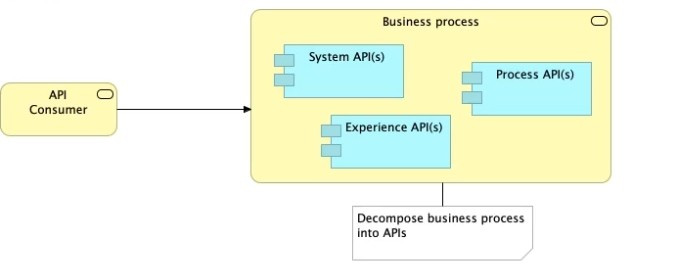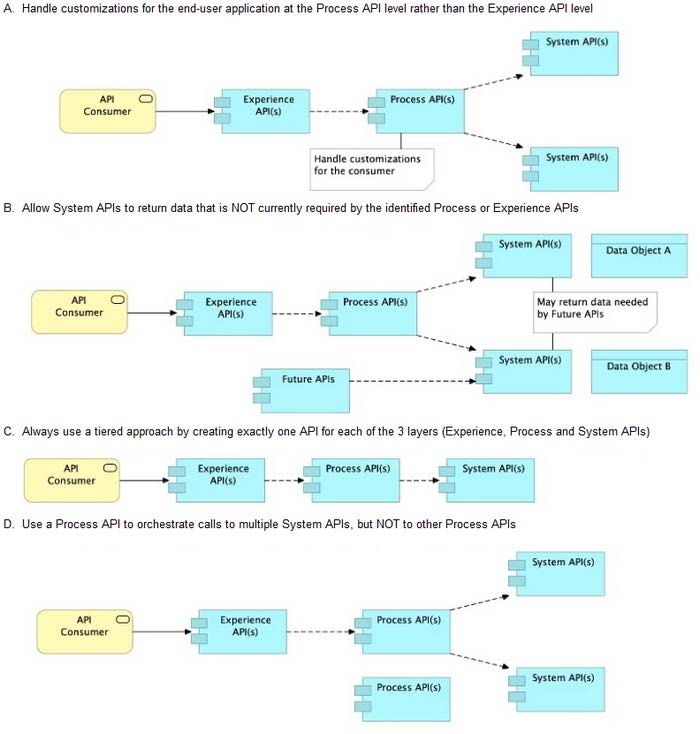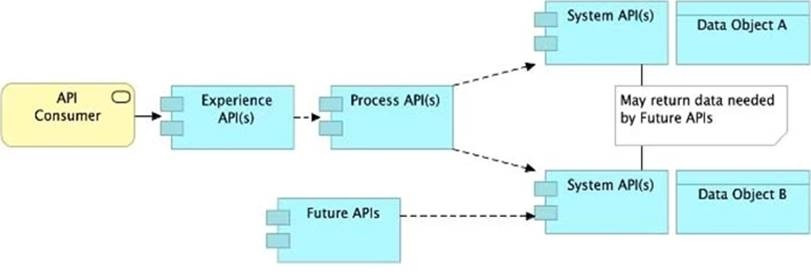Exam Details
Exam Code
:MCPA-LEVEL-1-MAINTENANCEExam Name
:MuleSoft Certified Platform Architect - Level 1 MAINTENANCECertification
:Mulesoft CertificationsVendor
:MulesoftTotal Questions
:80 Q&AsLast Updated
:Aug 12, 2025
Mulesoft Mulesoft Certifications MCPA-LEVEL-1-MAINTENANCE Questions & Answers
-
Question 41:
An organization makes a strategic decision to move towards an IT operating model that emphasizes consumption of reusable IT assets using modern APIs (as defined by MuleSoft).
What best describes each modern API in relation to this new IT operating model?
A. Each modern API has its own software development lifecycle, which reduces the need for documentation and automation
B. Each modem API must be treated like a product and designed for a particular target audience (for instance, mobile app developers)
C. Each modern API must be easy to consume, so should avoid complex authentication mechanisms such as SAML or JWT D
D. Each modern API must be REST and HTTP based
-
Question 42:
An API has been updated in Anypoint Exchange by its API producer from version 3.1.1 to 3.2.0 following accepted semantic versioning practices and the changes have been communicated via the API's public portal.
The API endpoint does NOT change in the new version.
How should the developer of an API client respond to this change?
A. The update should be identified as a project risk and full regression testing of the functionality that uses this API should be run
B. The API producer should be contacted to understand the change to existing functionality
C. The API producer should be requested to run the old version in parallel with the new one
D. The API client code ONLY needs to be changed if it needs to take advantage of new features
-
Question 43:
Traffic is routed through an API proxy to an API implementation. The API proxy is managed by API Manager and the API implementation is deployed to a CloudHub VPC using Runtime Manager. API policies have been applied to this API. In this deployment scenario, at what point are the API policies enforced on incoming API client requests?
A. At the API proxy
B. At the API implementation
C. At both the API proxy and the API implementation
D. At a MuleSoft-hosted load balancer
-
Question 44:
Refer to the exhibit.

What is the best way to decompose one end-to-end business process into a collaboration of Experience, Process, and System APIs?

A. Option A
B. Option B
C. Option C
D. Option D
-
Question 45:
A company wants to move its Mule API implementations into production as quickly as possible. To protect access to all Mule application data and metadata, the company requires that all Mule applications be deployed to the company's customer-hosted infrastructure within the corporate firewall. What combination of runtime plane and control plane options meets these project lifecycle goals?
A. Manually provisioned customer-hosted runtime plane and customer-hosted control plane
B. MuleSoft-hosted runtime plane and customer-hosted control plane
C. Manually provisioned customer-hosted runtime plane and MuleSoft-hosted control plane
D. iPaaS provisioned customer-hosted runtime plane and MuleSoft-hosted control plane
-
Question 46:
Version 3.0.1 of a REST API implementation represents time values in PST time using ISO 8601 hh:mm:ss format. The API implementation needs to be changed to instead represent time values in CEST time using ISO 8601 hh:mm:ss format. When following the semver.org semantic versioning specification, what version should be assigned to the updated API implementation?
A. 3.0.2
B. 4.0.0
C. 3.1.0
D. 3.0.1
-
Question 47:
A system API is deployed to a primary environment as well as to a disaster recovery (DR) environment, with different DNS names in each environment. A process API is a client to the system API and is being rate limited by the system API, with different limits in each of the environments. The system API's DR environment provides only 20% of the rate limiting offered by the primary environment. What is the best API fault-tolerant invocation strategy to reduce overall errors in the process API, given these conditions and constraints?
A. Invoke the system API deployed to the primary environment; add timeout and retry logic to the process API to avoid intermittent failures; if it still fails, invoke the system API deployed to the DR environment
B. Invoke the system API deployed to the primary environment; add retry logic to the process API to handle intermittent failures by invoking the system API deployed to the DR environment
C. In parallel, invoke the system API deployed to the primary environment and the system API deployed to the DR environment; add timeout and retry logic to the process API to avoid intermittent failures; add logic to the process API to combine the results
D. Invoke the system API deployed to the primary environment; add timeout and retry logic to the process API to avoid intermittent failures; if it still fails, invoke a copy of the process API deployed to the DR environment
-
Question 48:
An Order API must be designed that contains significant amounts of integration logic and involves the invocation of the Product API.
The power relationship between Order API and Product API is one of "Customer/Supplier", because the Product API is used heavily throughout the organization and is developed by a dedicated development team located in the office of the CTO.
What strategy should be used to deal with the API data model of the Product API within the Order API?
A. Convince the development team of the Product API to adopt the API data model of the Order API such that the integration logic of the Order API can work with one consistent internal data model
B. Work with the API data types of the Product API directly when implementing the integration logic of the Order API such that the Order API uses the same (unchanged) data types as the Product API
C. Implement an anti-corruption layer in the Order API that transforms the Product API data model into internal data types of the Order API
D. Start an organization-wide data modeling initiative that will result in an Enterprise Data Model that will then be used in both the Product API and the Order API
-
Question 49:
A Mule application exposes an HTTPS endpoint and is deployed to three CloudHub workers that do not use static IP addresses. The Mule application expects a high volume of client requests in short time periods. What is the most cost-effective infrastructure component that should be used to serve the high volume of client requests?
A. A customer-hosted load balancer
B. The CloudHub shared load balancer
C. An API proxy
D. Runtime Manager autoscaling
-
Question 50:
An API implementation is being designed that must invoke an Order API, which is known to repeatedly experience downtime.
For this reason, a fallback API is to be called when the Order API is unavailable.
What approach to designing the invocation of the fallback API provides the best resilience?
A. Search Anypoint Exchange for a suitable existing fallback API, and then implement invocations to this fallback API in addition to the Order API
B. Create a separate entry for the Order API in API Manager, and then invoke this API as a fallback API if the primary Order API is unavailable
C. Redirect client requests through an HTTP 307 Temporary Redirect status code to the fallback API whenever the Order API is unavailable
D. Set an option in the HTTP Requester component that invokes the Order API to instead invoke a fallback API whenever an HTTP 4xx or 5xx response status code is returned from the Order API
Related Exams:
Tips on How to Prepare for the Exams
Nowadays, the certification exams become more and more important and required by more and more enterprises when applying for a job. But how to prepare for the exam effectively? How to prepare for the exam in a short time with less efforts? How to get a ideal result and how to find the most reliable resources? Here on Vcedump.com, you will find all the answers. Vcedump.com provide not only Mulesoft exam questions, answers and explanations but also complete assistance on your exam preparation and certification application. If you are confused on your MCPA-LEVEL-1-MAINTENANCE exam preparations and Mulesoft certification application, do not hesitate to visit our Vcedump.com to find your solutions here.
